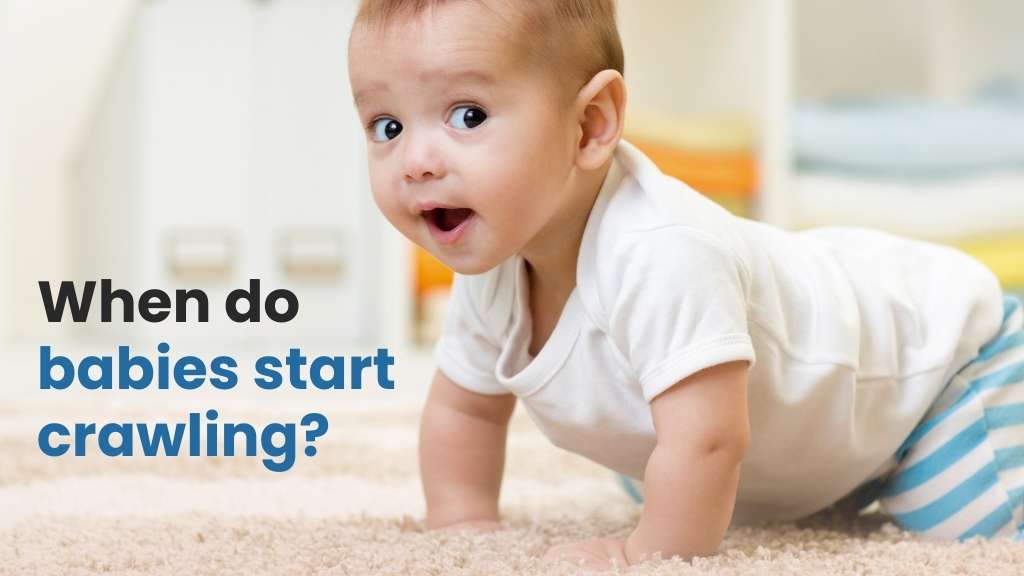
Table of Contents
Introduction : When do Babies start crawling
Watching your baby grow and achieve developmental milestones is an exciting and rewarding experience for parents. One of the most eagerly anticipated milestones is crawling. Crawling is a significant step in a baby’s journey toward independence and mobility. In this blog, we will explore the fascinating world of baby development and answer the question: when do babies start crawling?
Understanding the Basics
Crawling is a crucial milestone in a baby’s life that typically occurs between the ages of 6 to 10 months. However, it’s important to remember that each baby develops at their own pace, and there can be considerable variation in when do babies start to crawl.
Factors Affecting the Timing of Crawling
- Muscle Strength and Coordination: Before a baby can crawl, they need to develop the strength and coordination required to support their body weight on their arms and knees. This development is closely linked to their ability to hold their head up and sit independently.
- Tummy Time: Tummy time is an essential activity for babies that helps them develop the muscles needed for crawling. By placing your baby on their tummy for short periods each day, you encourage them to lift their head and strengthen their neck and shoulder muscles.
- Individual Differences: Every little one is unique, and some may reach the crawling milestone later or earlier than others. Genetics, temperament, and other individual factors can play a role in when a baby starts crawling.
The Crawling Process
The journey to crawling involves several stages of crawling:
- Rolling Over: Before crawling, many babies learn to roll over from their back to their tummy and vice versa. This rolling motion helps them become more familiar with being on their stomach and encourages muscle development.
- Scooting: Some babies start by scooting or shuffling on their tummy, using their arms and legs to push themselves forward or backward. This is a precursor to traditional crawling.
- Commando Crawl: Commando crawling involves moving forward while lying flat on the belly and using the arms to pull the body forward. It’s another transitional stage on the path to crawling on hands and knees.
- Crawling on Hands and Knees: Eventually, most babies progress to crawling on their hands and knees. This form of crawling is often seen between 6 to 10 months of age, but it can vary widely.
Encouraging Crawling
If you’re eager to see when do baby start crawling, here are some tips to encourage their development:
- Provide Tummy Time: Regular tummy time sessions help strengthen the muscles needed for crawling.
- Create a Safe Space: Baby-proof your home so your little one can explore freely without getting into dangerous situations.
- Offer Support: Place toys or objects just out of reach to motivate your baby to move and reach for them.
- Encourage Exploration: Allow your baby to explore their environment, whether on their tummy, sitting, or with your assistance.
- Be Patient: Remember that all babies develop at their own pace, and there’s no need to rush the process.
Different Crawling Styles!
Crawling is a significant milestone in a baby’s development, and it’s fascinating to observe the various crawling styles that infants may adopt. Below are some crawling styles:
Traditional Crawling
This is what most people envision when they think of a baby crawling. In this style, the baby moves forward on their hands and knees, alternating their arms and legs in a coordinated manner. It’s a well-balanced and efficient way to explore their environment.
Commando Crawling
Also known as the “army crawl,” commando crawling involves the baby moving forward while lying flat on its belly. They use their arms to pull themselves forward, dragging their lower body behind. It’s a transitional stage before traditional crawling for some babies.
Bear Crawling
Bear crawling resembles a bear’s movement. The baby crawls on their hands and feet (with their toes flexed), keeping their belly off the ground. It’s a less common style but still effective for mobility.
Crab Crawling
In crab crawling, the baby moves sideways or diagonally, with one hand and the opposite foot moving together. It can be entertaining to watch but is not as efficient for getting around as traditional crawling.
Bottom Shuffling
Some babies skip crawling altogether and develop a unique style called bottom shuffling. In this style, they sit on their bottom and use their hands to push themselves forward or backward. It’s a practical way for them to explore their surroundings.
Rolling
While not technically crawling, rolling can be a form of mobility for some babies. They roll from place to place, using their newfound rolling skills to reach toys or objects.
Wriggling
Before mastering crawling, some babies use a wriggling or scooting motion. They push themselves along the floor with their belly and legs, using their arms to assist.
Rocking
Babies may sometimes rock back and forth on their hands and knees without fully committing to forward movement. This rocking motion can be a precursor to traditional crawling.
It’s important to note that these crawling styles are not necessarily indicative of developmental delays. Babies often experiment with different techniques as they explore and build the strength and coordination needed for traditional crawling. If you have concerns about your baby’s development, it’s always a good idea to consult with a pediatrician to ensure they are on the right track.
Conclusion; When Do Babies Crawl?
Crawling is a significant developmental milestone in a baby’s life, marking the beginning of their journey toward independence and mobility. While most babies start crawling between 6 to 10 months, it’s essential to remember that each child is unique. Encourage your baby’s development, provide a safe environment, and be patient as they embark on this exciting stage of their growth. Before you know it, your baby will be exploring the world on their own!










